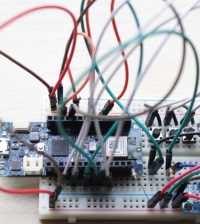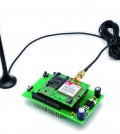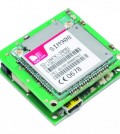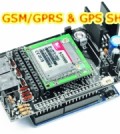- How to Adjust X and Y Axis Scale in Arduino Serial Plotter (No Extra Software Needed)Posted 4 months ago
- Elettronici Entusiasti: Inspiring Makers at Maker Faire Rome 2024Posted 4 months ago
- makeITcircular 2024 content launched – Part of Maker Faire Rome 2024Posted 7 months ago
- Application For Maker Faire Rome 2024: Deadline June 20thPosted 8 months ago
- Building a 3D Digital Clock with ArduinoPosted 1 year ago
- Creating a controller for Minecraft with realistic body movements using ArduinoPosted 1 year ago
- Snowflake with ArduinoPosted 1 year ago
- Holographic Christmas TreePosted 1 year ago
- Segstick: Build Your Own Self-Balancing Vehicle in Just 2 Days with ArduinoPosted 1 year ago
- ZSWatch: An Open-Source Smartwatch Project Based on the Zephyr Operating SystemPosted 1 year ago
Web thermostat with Arduino
[singlepic id=205 w=500 float=center]
How to use
Opening in the browser the thermostat IP address (defined by the Arduino firmware) you can access the page and set the temperature of the system, the functions or active manually the boiler.
In the web page in memory dell’Arduino is also inserted a reference to the graphs of the gadget sites, in the graph bottom of the page where you can choose which display period (from 1 minute to 1 year).
The web page contains the top, some buttons and boxes for the settings. There is a refresh button and below there are an indication of the status of the boiler (OFF or ON): the system can be used for both heating systems both cooling and air conditioning: it depends on how connected the relay. In fact, with the exchange between C and NO it controls the boiler, while that between C and NC controls the air conditioner, this is because until the temperature is less than the threshold, the relay is energized and closes NO to NC, so it can turn on a boiler or other heating system, while when the temperature exceeds the set threshold, the relay returns to rest and NC close to C, going to control the cooling system.
We continue with the analysis of web page talking about the radio buttons under the present condition of the boiler, which are three and let you set how our system should work: clicking on the relay sensor is controlled based on temperature detected by the Dallas sensor, while opting for manual you can make the relay turn on and off using the On-screen buttons Boiler (relay activated), and Off Boiler (relay deactivated). Finally, opting for thermostat, the relay will be controlled according to the condition of our input IN interface card, this mode allows you to enslave the functioning of our system to an existing thermostat is substantially repeated in the environment and to relay the condition of the thermostat itself.
Below the radio buttons that define how, is the section of the temperature setting: Click in the box, you can set at will (within limits) the temperature at which the system should take, the setting made applies here by clicking the Set temperature.
[singlepic id=204 w=500 float=center]
We conclude the description of the web page with the chart, which summarizes the time courses of temperature measured by the sensor and the display may relate to a period of time to choose between 1 minute and 1 year.
As mentioned, the public system at that site www.pachube.com the value of the measured temperature, in a personal page reserved for each registered user, this site provides a service for storage and display of data from various sources, ranging from information gathered from sensors in environmental data, various measures, then everything is shared, or made accessible to registered users of the community.
In order to publish data on www.pachube.com you must first register and create an account, then take your chosen username and validated by the site and write in the special section of the firmware on the feed, without informing the user name of firmware, our system will not be able to access the site and publish the data.
Delivery of data for the upgrade can be done with a frequency set by firmware, bearing in mind the limits allowed by the site (about 50 accesses per hour) for obvious reasons, because if any application tries to access in real time site for uploading the data, at some point the bandwidth of the connection used by it and would soon be saturated with its server would have some problem to run.
Well, having said that we can conclude by pointing out that clicking on the word pachube that is below the temperature graph, you enter the page on www.pachube.com mail account used by the system to publish data on the page shown address of the corresponding link, containing the account name.
<Previous page – Next page>
About Boris Landoni
Boris Landoni is the technical manager of Open-Electronics.org. Skilled in the GSM field, embraces the Open Source philosophy and its projects are available to the community.Related Posts
8 Comments
Leave a Reply
Cancel reply
OpenSource Products
-
SONY color camera module, 700 TV Lines
Color camera module equipped with a 1/3″ CCD sensor and...
- Posted 7 months ago
- 0
-
ESP32 Low Power Module
ESP32 Low Power Module, based on Espressif’s SoC capable of...
- Posted 8 months ago
- 0
-
Power supply latch
This power supply latch provides power to the external circuit...
- Posted 8 months ago
- 0
-
GSM/4G Remote Control with DTMF Commands
Two-way remote control system, based on the GSM/4G A7682E module...
- Posted 9 months ago
- 0
-
Acoustic amplifier – in DIY Kit
This kit creates a microphone amplifier with an output suitable...
- Posted 1 year ago
- 0
-
Clap sensor switch – in DIY Kit
It is capable of recognizing the sound of clapping hands...
- Posted 1 year ago
- 2
-
Liquid level indicator for tanks – in DIY kit
This monitoring device is useful for keeping track of the...
- Posted 1 year ago
- 0
-
LED candle with Breath-Activated ON/OFF – in DIY Kit
This LED candle with breath-activated ON/OFF function draws inspiration from...
- Posted 1 year ago
- 0
Tutorials
-
How to Adjust X and Y Axis Scale in Arduino Serial Plotter (No Extra Software Needed)
The Serial Plotter in Arduino is an excellent tool for...
- Posted 4 months ago
- 3
-
PCB CAD, A SELECTION GUIDE
Getting to know and evaluate the software offer for PCB,...
- Posted 4 years ago
- 0
-
DIY Sensor – Innovation & Implementation
A sensor converts data such as heat, light, sound,...
- Posted 4 years ago
- 0
Mods and Hacks
-
The flame that doesn’t burn
Based on Neopixel and a special ultra-thin Arduino, it simulates...
- Posted 3 years ago
- 1
-
Here are the Winners from the 3Drag 3d printing contest
Here we are, eventually the contest has come to an...
- Posted 10 years ago
- 0
-
Updates from the 3Drag 3dprinting contest: Roland Hoffert’s Hacks
Roland Hoffert, from www.eytec.de, submitted us this 3Drag (Velleman K8200...
- Posted 10 years ago
- 0
-
Updates from the 3Drag 3dprinting contest: Karl Seiss’s Hack
Karl Seiss from Austria made a very clever hack to...
- Posted 10 years ago
- 0
-
Arduino ISP (In System Programming) and stand-alone circuits
We use an Arduino to program other ATmega without...
- Posted 13 years ago
- 226
-
Localizer with SIM908 module
The device is based on a GSM/GPRS module with...
- Posted 13 years ago
- 187
-
GSM GPS shield for Arduino
Shield for Arduino designed and based on the module...
- Posted 12 years ago
- 181
-
Small Breakout for SIM900 GSM Module
Some post ago we presented a PCB to mount...
- Posted 14 years ago
- 115
-
How to Control NeoPixel Installations via Wi-Fi Using Fishino and NodeMCU with Python
We create NeoPixel light installations with Fishino and NodeMCU...
- Posted 3 months ago
- 0
-
How to Adjust X and Y Axis Scale in Arduino Serial Plotter (No Extra Software Needed)
The Serial Plotter in Arduino is an excellent tool...
- Posted 4 months ago
- 3
-
Elettronici Entusiasti: Inspiring Makers at Maker Faire Rome 2024
Maker Faire Rome 2024 is ready to amaze the...
- Posted 4 months ago
- 0
-
makeITcircular 2024 content launched – Part of Maker Faire Rome 2024
Applications to MakeITcircular must be in by October 3,...
- Posted 7 months ago
- 0
-
SONY color camera module, 700 TV Lines
Color camera module equipped with a 1/3″ CCD sensor...
- Posted 7 months ago
- 0
















Pingback: business model innovation design » "Look around your house
Pingback: Control de temperatura vía Web con Arduino | Automatismos Mar del Plata
Pingback: Arduino | Pearltrees
Pingback: Happy new year from Open-Electronics.org: best posts in 2016, thank you! | Open Electronics